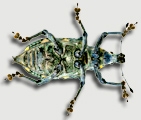Citation:
Abstract:
Amber holds special paleobiological significance due to its ability to preserve direct evidence of biotic interactions and animal behaviors for millions of years. Here we review the finding of Hallucinochrysa diogenesi Pérez-de la Fuente, Delclòs, Peñalver and Engel, 2012, a morphologically atypical larva related to modern green lacewings (Insecta: Neuroptera) that was described in Early Cretaceous amber from the El Soplao outcrop (northern Spain). The fossil larva is preserved with a dense cloud of fern trichomes that corresponds to the trash packet the insect gathered and carried on its back for camouflaging and shielding, similar to that which is done by its extant relatives. This finding supports the prominent role of wildfires in the paleoecosystem and provides direct evidence of both an ancient planteinsect interaction and an early acquisition of a defensive behavior in an insect lineage. Overall, the fossil of H. diogenesi showcases the potential that the amber record offers to reconstruct not only the morphology of fossil arthropods but, more remarkably, their lifestyles and ecological relationships.
